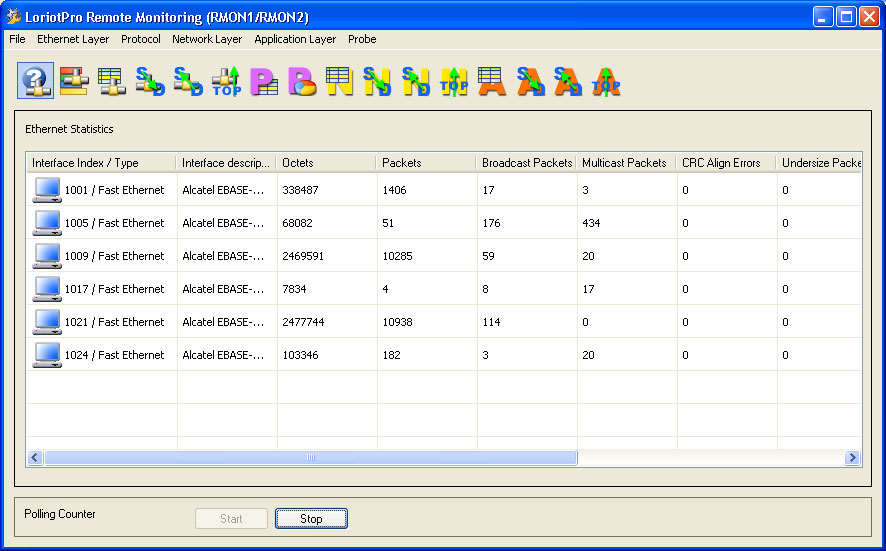RMON GUI - Remote network MONitoring
Administrator handbook
|
|
RMON GUI - Remote network MONitoring
|
Table of contents |
|
The "ethernet statistics table" provides ethernet traffic statistics since the rmon probe was started.
SNMP data are collected from the RMON probe. The probe should be compatible with the RMON MIB RFC1757.
To access the "ethernet statistics table"
click on the icon ![]() or select it in the "Ethernet Layer" menu the option : Ethernet Statistics
or select it in the "Ethernet Layer" menu the option : Ethernet Statistics
The Ethernet statistics table is displayed

Table description
| Column | Description |
|---|---|
| Interface Index / Type | Index of the interface working as an RMON Probe. Type of physical layer (Ethernet only) |
| Description | The description provided by the snmp agent for this interface |
| Octets | The total number of octets of data (including those in bad packets) received
on the network (excluding framing bits but including FCS octets). This object can be used as a reasonable estimate of ethernet utilization. If greater precision is desired, the etherStatsPkts and etherStatsOctets objects should be sampled before and after a common interval. The differences in the sampled values are Pkts and Octets, espectively, and the number of seconds in the interval is Interval. These values are used to calculate the Utilization as follows: Pkts
* (9.6 + 6.4) + (Octets * .8) The result of this equation is the value Utilization which is the percent utilization of the ethernet segment on a scale of 0 to 100 percent. |
| Packets | The total number of packets (including bad packets, broadcast packets, and multicast packets) received. |
| Broadcast packets | The total number of good packets received that were directed to the broadcast address. Note that this does not include multicast packets. |
| Multicast packets | The total number of good packets received that were directed to a multicast address. Note that this number does not include packets directed to the broadcast address. |
| CRC ALign Errors | The total number of packets received that had a length (excluding framing bits, but including FCS octets) of between 64 and 1518 octets, inclusive, but but had either a bad Frame Check Sequence (FCS) with an integral number of octets (FCS Error) or a bad FCS with a non-integral number of octets (Alignment Error). |
| Undersize packets | The total number of packets received that were less than 64 octets
long (excluding framing bits, but including FCS octets) and were otherwise well formed. |
| Oversize packets | The total number of packets received that were longer than 1518
octets (excluding framing bits, but including FCS octets) and were otherwise well formed. |
| Fragments | The total number of packets received that were less than 64 octets in
length (excluding framing bits but including FCS octets) and had either
a bad Frame Check Sequence (FCS) with an integral number of octets (FCS
Error) or a bad FCS with a non-integral number of octets (Alignment Error).
Note that it is entirely normal for etherStatsFragments to increment. This is because it counts both runts (which are normal occurrences due to collisions) and noise hits. |
| Jabber | The total number of packets received that were longer than 1518 octets
(excluding framing bits, but including FCS octets), and had either a bad Frame Check Sequence (FCS) with an integral number of octets (FCS Error) or a bad FCS with a non-integral number of octets (Alignment Error). Note that this definition of jabber is different than the definition
in IEEE-802.3 section 8.2.1.5 |
| Collisions | The best estimate of the total number of collisions on this Ethernet
segment.
The value returned will depend on the location of the RMON probe. Section
8.2.1.3 (10BASE-5) and section 10.3.1.3 (10BASE-2) of IEEE standard 802.3
states that a station must detect a collision, in the receive mode, if
three or more stations are transmitting simultaneously. A repeater port
must detect a collision when two or more stations are transmitting simultaneously.
Thus a probe placed on a repeater port could record more collisions than
a Note also that an RMON probe inside a repeater should ideally report
collisions between the |
Sorting column
You can sort column by a double click on the column header
 www.loriotpro.com
www.loriotpro.com |
|